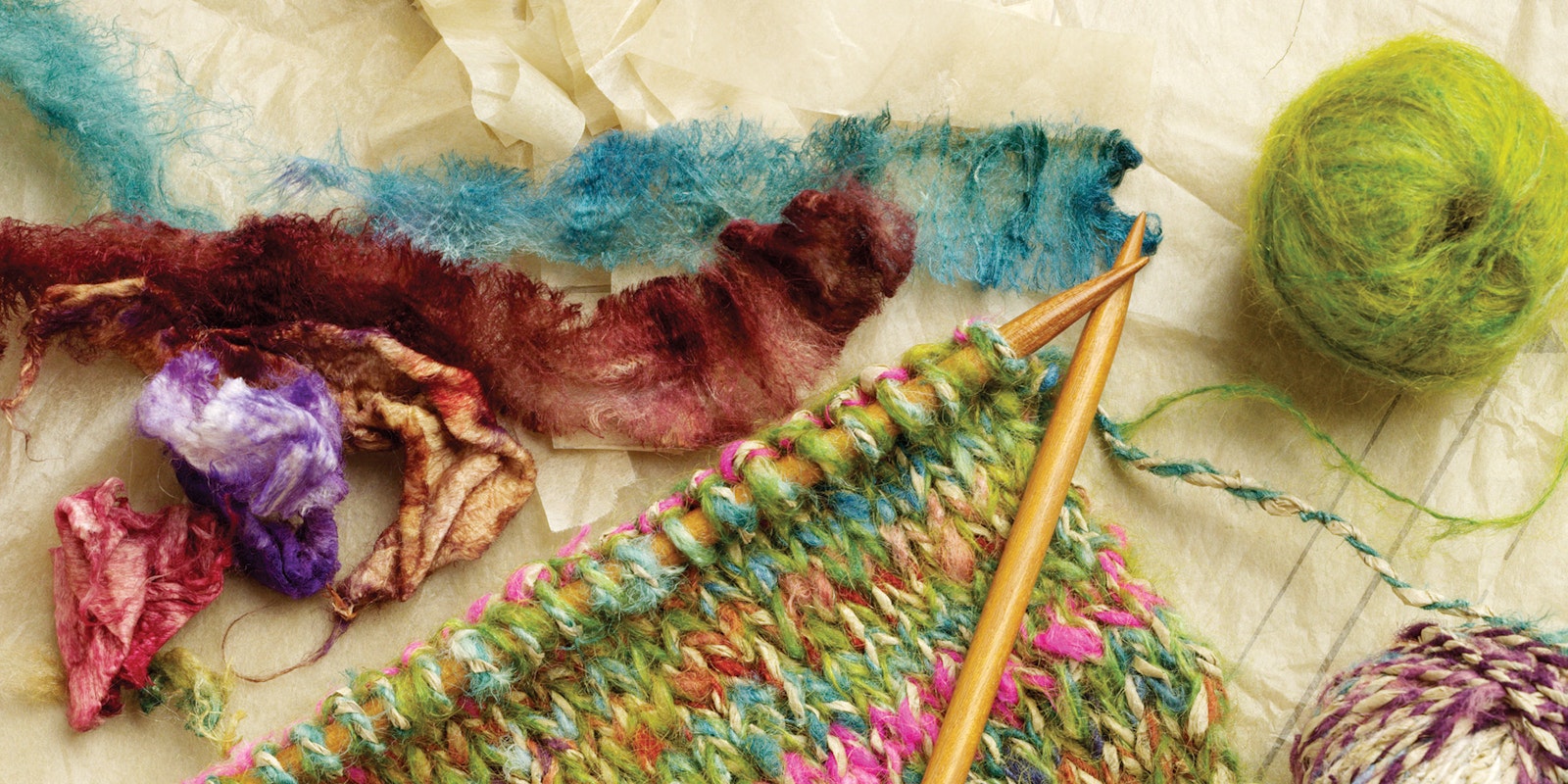I have had a long-lasting passion for paper. Surely it came with an early love of books, one of my first remembered possessions, but it quickly spread to paper in many forms: precious handmade papers, industrial waste, stacks of school paper, tissue wrapping, exquisitely printed origami paper, corrugated boxes. They all have a relentless fascination for me.
In my years at my studio in Victoria, British Columbia, Canada, I made cast-paper tapestries, wove with paper, used it for baskets, made intricate Japanese boxes, bound books, dyed paper, and marbleized it. I made paper from nettles, iris stalks, gladioluses, onion skins, recycled industrial waste, junk mail, milk cartons, egg cartons, and endless other surprisingly numerous cellulose sources.
But I Never Spun it
How could I not have spun paper? It seems only natural to combine two of my grand passions to make beautiful and intriguing cloth. But I didn’t even consider it until I became seriously committed to creating yarns based on recycling. When making my list of all the discarded fibers that our society fails to reuse creatively, paper was hard to miss.
It wasn’t that I didn’t know that paper had yarn potential. One of the great advantages of growing up as a fiber junkie on the West Coast is the presence of a well-established Japanese culture. Museums, private collections, art exhibits, and an abundance of stores that sell both Japanese fabrics and Japanese art books abound. For a budding textile artist like me, studying Japanese textiles was both inspiring and enriching.
As a young weaver, I saw many examples of shifu, a Japanese cloth woven with paper threads. Although clothing in Japanese culture usually has distinct class implications, the use of shifu was universal before the introduction of commercially produced cotton in Japan in 1868. I saw shifu garments from the sixteenth century worn by peasant farmers, simply made from yarn spun from recycled paper; the woven cloth was dyed rich deep blues with indigo. Durable enough for work clothes, this type of shifu was also used for everyday household textiles. There are many examples of shifu: plain, ikat-dyed or printed, used for quilt covers, screens, and norin (a small cloth hung in doorways).
I also saw exquisite pieces made with Saga Nishiki, a very rare type of shifu cloth woven with tiny gold or silver lacquered threads usually spun from paper made from mulberry bark. This ancient technique, spellbindingly beautiful, dates back in history to the Edo period (1600 to 1868). Traditional stories say that this technique was developed by Princess Kashioka, an invalid, while she was confined to her bed. Later, it became a popular pastime for noble women. Saga Nishiki uses fine lacquered paper threads as the warp. These are threaded in intricate brocade patterns and woven with a very fine silk thread for the weft. The warp-faced technique, which is extremely demanding, uses a special loom that holds the warp threads perfectly tensioned with little abrasion. The threads are manipulated by hand, slowly and patiently. Not surprisingly, it was produced in very limited amounts; a master weaver could produce about 10 inches of cloth a day. Historically, it was woven by women of the noble class. Most articles made with Saga Nishiki are decorative: little bags, obis (traditional Japanese sashes), wrapped handles for ceremonial swords. It is still being handspun and woven in Japan.
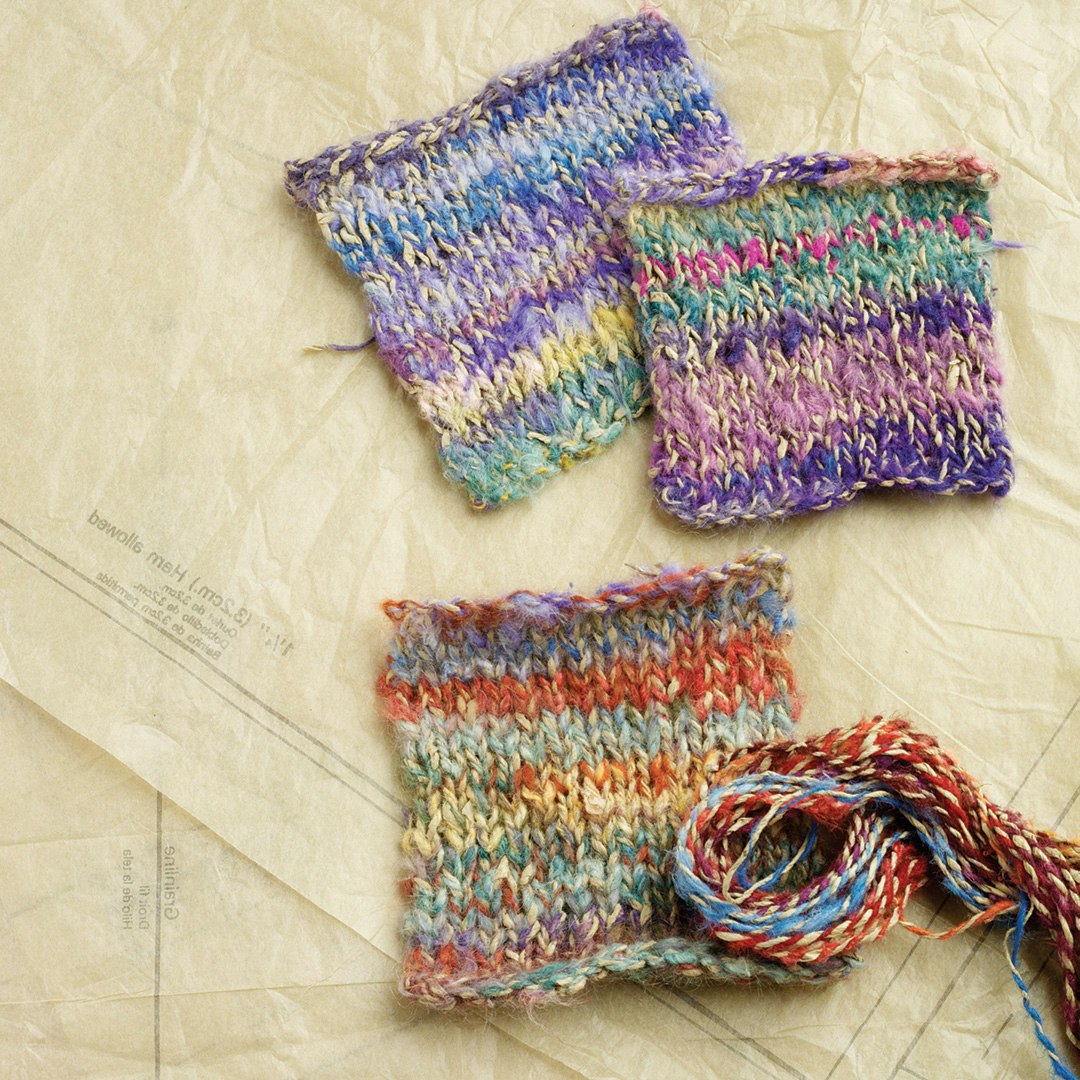 Silk and sewing-pattern paper knitted swatches: (top) washed; (Middle) not washed; (Bottom) same yarn knitted with an additional kid mohair strand, not washed
Silk and sewing-pattern paper knitted swatches: (top) washed; (Middle) not washed; (Bottom) same yarn knitted with an additional kid mohair strand, not washed
Choosing Paper to Spin
Rice paper, mulberry paper, kraft paper, newspaper, wrapping paper, watercolor paper, tissue paper, gum wrappers, love letters, posters, handmade art papers—almost any paper can be spun, but some are certainly more interesting than others and some spin more easily than others. I can spin paper towels fairly easily but the end result lacks the transformation that I look for when working with a new material. Spun, that paper towel still looks, to me, like a paper towel. There were some papers I simply could not spin. My most spectacular failure in paper spinning, so far, is ordinary gold and silver finished tissue paper. I loved the look of it, especially when I knitted it and then treated it by ironing it flat. It was magical but sadly, not more than 4 inches long. No matter what I did, I could not spin a usable length of yarn; I could produce only enough to make something the size of a postage stamp.
Even if a paper does spin well, the finished surfaces can vary greatly in strength and visual appeal. Not all wash or take dye well. Traditionally, papers that were spun with the intention of making a wearable cloth were made with long-fibered papers such as mulberry, abaca, and recycled linen rag.
For most of the paper yarns in this article, I have chosen to work with sewing-pattern paper, which uses some abaca fiber in its construction. Abaca is a plant from the Philippines that is closely related to the banana plant. Known for its long, strong fibers, it has been used for making strong ropes and durable paper for centuries.
If this is your first adventure in spinning with paper, pattern paper has several good qualities: it is strong, it washes easily, it accepts dyes well, and it is abundantly available. It also generally comes in large sheets that make for fewer joins while spinning. Pattern paper comes in a variety of beautiful golden colors that blend well with other natural materials such as stone, fleece, and wood.
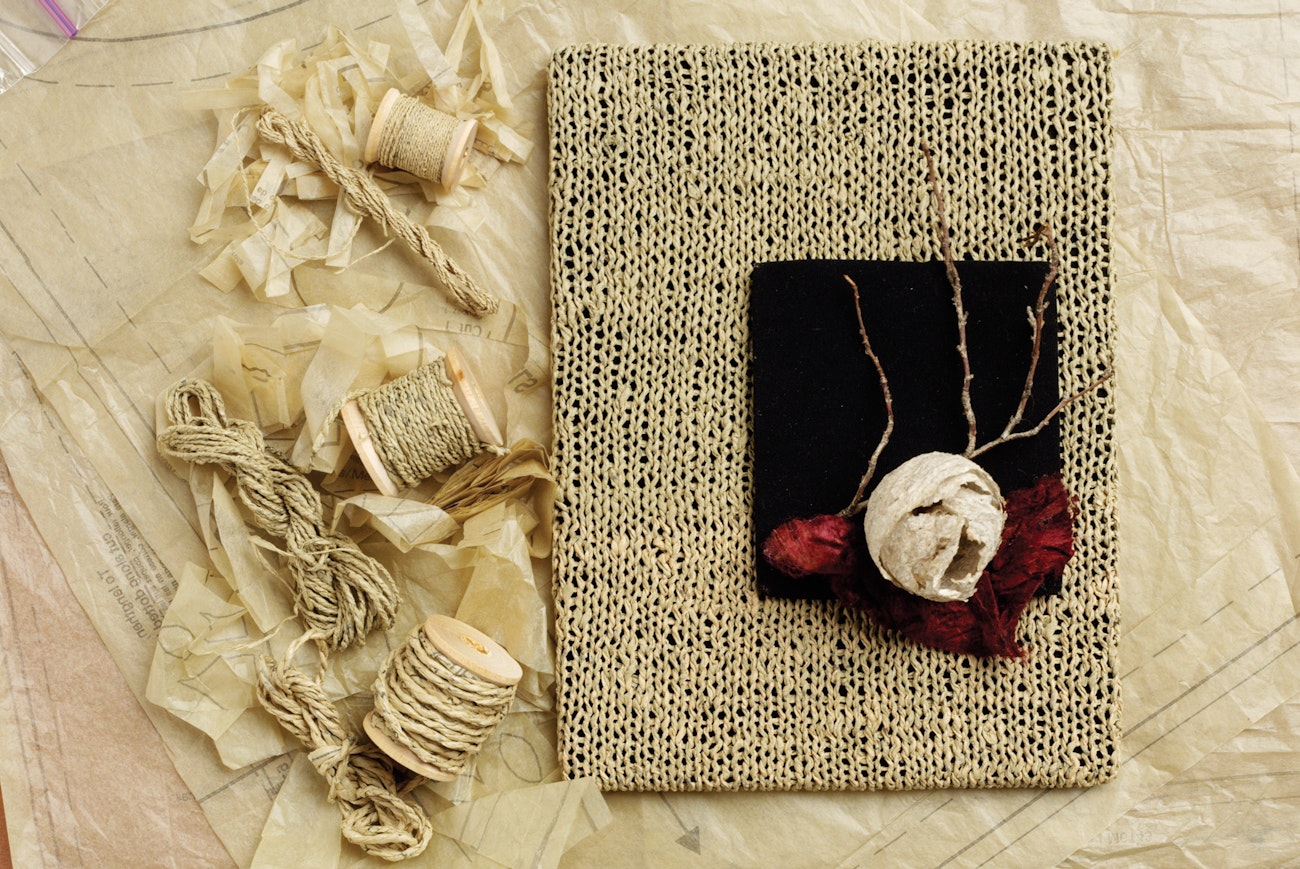 Paper made by hornets with handspun yarn made from sewing-pattern paper.
Paper made by hornets with handspun yarn made from sewing-pattern paper.
Cutting Paper in Preparation for Spinning
The following steps for preparing paper for spinning apply to all types of paper. After you have chosen the paper that you want to spin, you need to decide what width to cut the paper. The narrower you cut it, the finer it will spin. The width that the paper can be cut without breaking during the spinning process varies with the type of paper you choose and how you prepare it for spinning. In most cases, long-fibered paper can be cut finer. Try to see if the paper has a distinct grain (the direction that it can be torn) and try to cut with the grain. Most newsprint does not have a distinct grain but most art papers, handmade paper, Japanese mulberry paper, and watercolor papers do. The pattern paper I use has a grain, but it is not as pronounced as art paper. As the paper is quite strong, I have chosen to cut it to get the maximum length rather than cutting always with the grain.
A simple way to cut paper for spinning is to use a paper shredder; a paper cutter or a rotary blade also works well. Most paper can be cut easily and quickly by folding it in multiple layers. Fold the paper so you get the longest length possible. While a little more time-consuming, simply cutting with scissors, which is what I did because I like a more inconsistent edge, works just fine. With handmade papers, try cutting them in spirals to get the longest possible length without awkward edges.
It is a good idea to sample the paper before you undertake all the preparation. Cut and spin a sample; try it as a singles, a two-ply, a three-ply. Give it a wash in hot soapy water, especially if you plan on using it for clothing. It is amazing how well most paper yarns stand up to washing; it also relaxes and redistributes the twist, just as it would with a yarn spun from a more traditional fiber. Washing also changes the surface a bit, giving the yarn a softer hand. I also usually knit a small sample, wash it, and then dry it in my clothes dryer with a load of towels. When I want the sculptural waxed surface and superstrength of untreated paper for baskets or art pieces I use it unwashed.
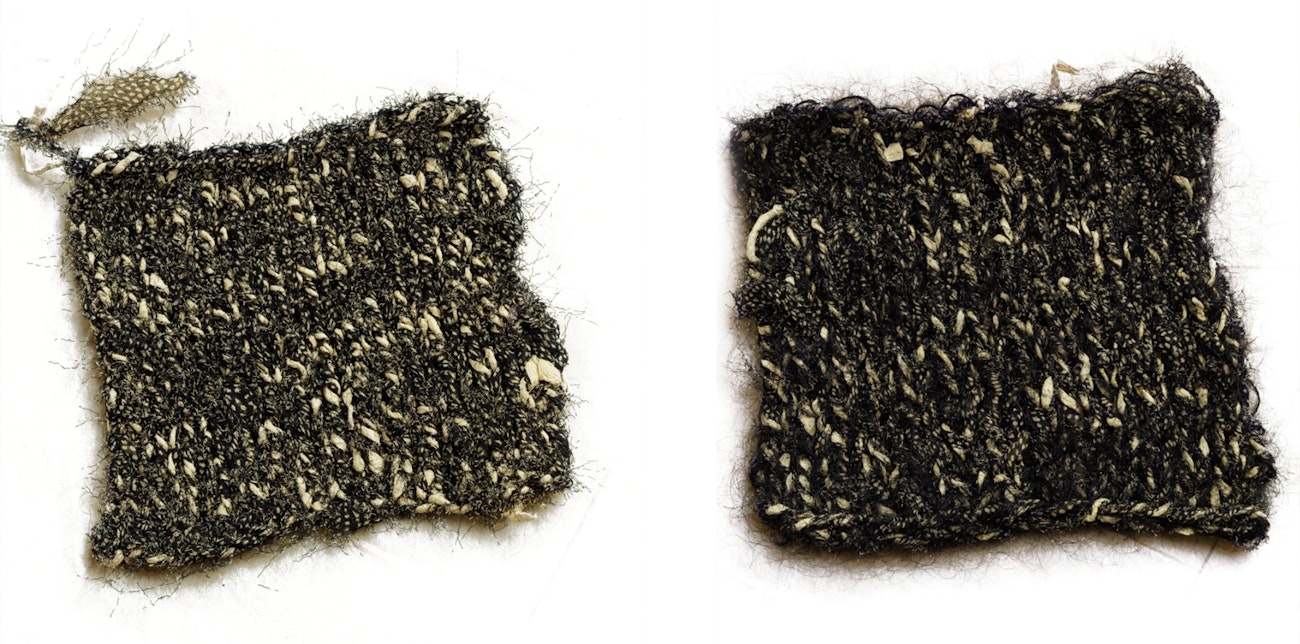 Left: Mother-of-the-bride rag with pattern paper swatch 1—handwashed in hot soapy water, dried in the dryer with regular heat and towels. Right: Mother-of-the-bride rag with pattern paper swatch 2—2-ply, knitted with black silk kid mohair, washed in hot soapy water
Left: Mother-of-the-bride rag with pattern paper swatch 1—handwashed in hot soapy water, dried in the dryer with regular heat and towels. Right: Mother-of-the-bride rag with pattern paper swatch 2—2-ply, knitted with black silk kid mohair, washed in hot soapy water
Allowing the Paper to Rest
Traditionally, the cut paper strips are misted with water and then left to rest, anywhere from a day or two to several years. The next step, traditionally, would be to rub each strand back and forth over a stone, somewhat abrading the paper and softening it slightly. For my paper yarn, I lightly misted the cut paper and let it sit overnight. I tried spinning it just as it was, simply cut and misted. Then I spun a sample from paper strips cut and vigorously crumpled by hand, my version of rubbing it over a stone.
The results were surprisingly different. Spun straight from the cut paper, the yarn has a shiny, very sculptural surface with clearly defined ply twist. It looks as if it has been waxed and polished. It was tricky to join and tricky to spin; the singles yarn was consistently overspun. The crumpled paper spun easily and joined easily. It has a soft matte surface and is very pliable. Somewhat similar to a woolen-spun yarn, the ply twist has less definition.
Both preparations made yarns strong enough to make a warp. Each type of yarn is useful, depending on the structure and the effect you wish to achieve. For instance, paper yarns have been traditionally used to make baskets and rugs. Having a rigid structure, the uncrumpled paper preparation would work well for these while the softer, more drapable crumpled paper would be more suitable for cloth.
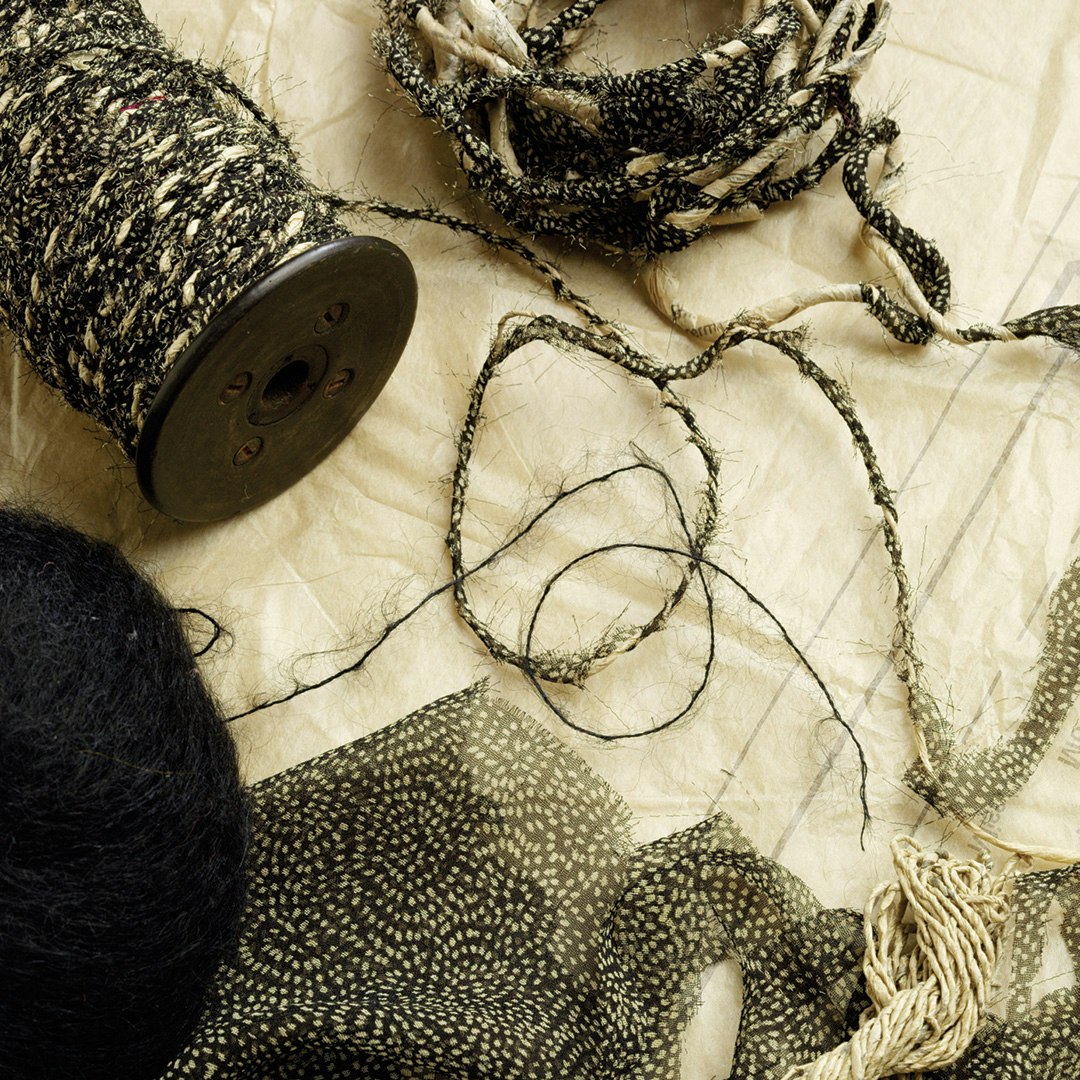 Mother-of-the-bride yarn made from recycled silk fabric and sewing-pattern paper yarn.
Mother-of-the-bride yarn made from recycled silk fabric and sewing-pattern paper yarn.
Spinning Paper Yarns
It is helpful when you spin paper to think about it as a long fiber, somewhat similar to flax or hemp. Like these bast fibers, paper is easily overspun. I spun and plied all the yarns I used for this article on my Jensen Tina II wheel. Originally, I tried using my 10:1 pulley, as I wanted a fairly fine yarn (about 22 wraps per inch) with a fairly medium twist (24 twists per inch) for that diameter. Using this pulley, which is what I would have chosen for a medium-fine yarn spun from wool, the yarn was impossibly overspun, and I had to stop frequently and wind it on by hand. Realizing that it was going to need a great deal less twist per inch than I had first thought, I moved from one pulley to the next. Finally, to my surprise, I ended up on my large pulley, using the 8.5:1 ratio. This dropped the twists per inch down to 18 in the singles. It was so much easier to spin using this ratio, and the yarn, even as a singles, was still surprisingly strong.
Once I found the right pulley, it was fairly easy to spin the paper. Joining does take a bit of care, but I found that overlapping the two pieces about a quarter of an inch and giving them a bit of twist to the right with the thumb and finger of the drafting hand helps make the join strong and less conspicuous. Sometimes, as when spinning flax, dampening the fingers a bit helps the twist at the join. Be careful, though, because too much moisture weakens the paper and, even though it joins together perfectly, if it is too damp, it will break just as it starts to wind on the bobbin. If a smooth-surfaced yarn is important to your design, try cutting the ends of the paper strips on a 45-degree angle. This will help produce a very smooth-surfaced join.
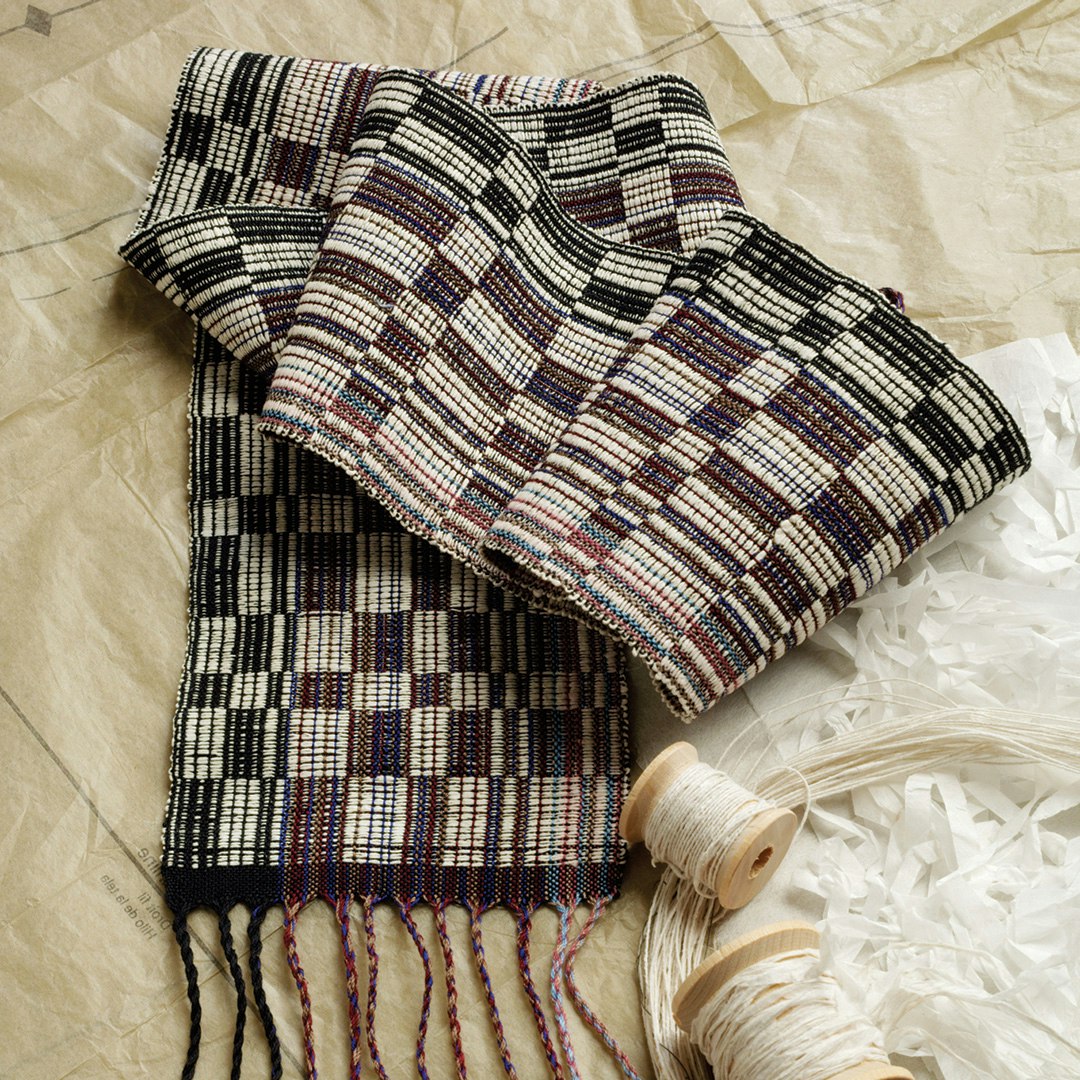 Jeannine Glaves wove this scarf using a 10/2 cotton warp. The weft is from Japanese mitsumata paper. She cut ¼" continuous strips with the grain of the paper and spun it using her bobbin winder as a spindle.
Jeannine Glaves wove this scarf using a 10/2 cotton warp. The weft is from Japanese mitsumata paper. She cut ¼" continuous strips with the grain of the paper and spun it using her bobbin winder as a spindle.
Plying and Cabling
Paper yarns will ply and cable as any traditional fiber might. I found the biggest difference in how these yarns reacted was due to how I treated them after they were cut and before they were spun into singles. The yarns that I did not crumple showed very strong ply and cable twist definition, and the crumpled yarns yielded a much softer definition, even though I plied and cabled them on the same pulley.
I did find spinning paper to be hard on my hands, not in the sense of muscle strain, but the paper was a bit abrasive when it was twisting in my fingers, especially the paper that I chose not to crumple. I could definitely feel it in the tips of my fingers after an hour or so of spinning. Also, I found that my hands dried out terribly. I learned to use a good hand cream before I spun and again after I finished spinning. And I did get several paper cuts, especially between the joints on my drafting hand.
For me, thinking and studying about what a material can do and actually working with that material in my own hands are light-years apart as experiences. I am frequently guilty of saying to myself, “Oh, that’s how that works,” without doing it. Spinning paper has reminded me, once again, that what we experience with our hands and what we experience with our intellect are different. One is not necessarily better than the other, just different, and both are necessary. What started as an exercise in recycling has ended leaving me with at least a million and maybe two million “what if” and “what next” questions and a whole new appreciation for a material that is so common that it is rarely considered for its textile possibilities.
Tips
- Note that there are dyelots in paper—even pattern paper from the same package can vary in color from sheet to sheet.
- The grain in paper is produced by the motion of the water in the paper vat. The paper tears in the same direction that the water was moving as the screen was lifted out of the water.
- Many papers are stronger and sharper than they appear. Guard against paper cuts, especially when spinning paper that has not been crumpled.
- Use a good hand cream, rich in lanolin, to help offset paper’s drying effect on your hands.
- Do test your paper yarns for flammability. When tested, mine burned with a low flame, and while they did burn for several inches, all my samples self-extinguished.
Looking for other unique materials to spin? This article and others can be found in the Spring 2011 issue of Spin Off.
Also, remember that if you are an active subscriber to Spin Off magazine, you have unlimited access to previous issues, including Spring 2011. See our help center for the step-by-step process on how to access them.
Judith MacKenzie of Forks, Washington, has been a textile artist for over thirty years. She wrote The Intentional Spinner (Interweave, 2008), and she’s starred in a number of spinning videos.
Originally published March 9, 2020; updated January 16, 2023.

